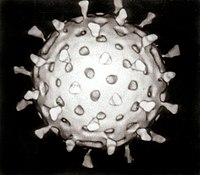
Photo from wikipedia
There is a challenge to obtain an ultrasensitive and rapid approach to detect bacteria and identify resistance. As a powerful bioanalytical tool, surface-enhanced Raman scattering (SERS) in bacterial detection have… Click to show full abstract
There is a challenge to obtain an ultrasensitive and rapid approach to detect bacteria and identify resistance. As a powerful bioanalytical tool, surface-enhanced Raman scattering (SERS) in bacterial detection have attracted increasing attentions. Herein, we developed a SERS-active Au@Ag core-shell nanorod (Au@AgNR) tag platform for ultrasensitive bacteria detection and antibiotic-susceptibility testing (AST). The platform established that surface enhanced Raman scattered Rhodamine 6G (R6G) absorption at 1517 cm-1 had a good linearity (RI = 3865 + 193logC; R2 = 0.97) with logarithm of E. coli concentration over a range of 107-102 CFU (colony forming unit)/mL with limit of detection as low 102 CFU/mL. When E. coli was exposed to ampicillin at minimum inhibitory concentration (MIC, 4 μg/mL), Raman spectroscopy showed the obvious variation between ampicillin-susceptible E. coli (Amp--E. coli) and the ampicillin-resistant E. coli (Amp+-E. coli). Combined with principal component analysis (PCA) statistical analysis, the Raman intensity variation mentioned above allows to obtain rapid antibiotic resistance testing (<3.5 h). In addition, E.coli spiked into blood from C57BL/6 mice can be identified clearly, indicating the potential for point-of-care diagnostics.
Journal Title: Talanta
Year Published: 2020
Link to full text (if available)
Share on Social Media: Sign Up to like & get
recommendations!